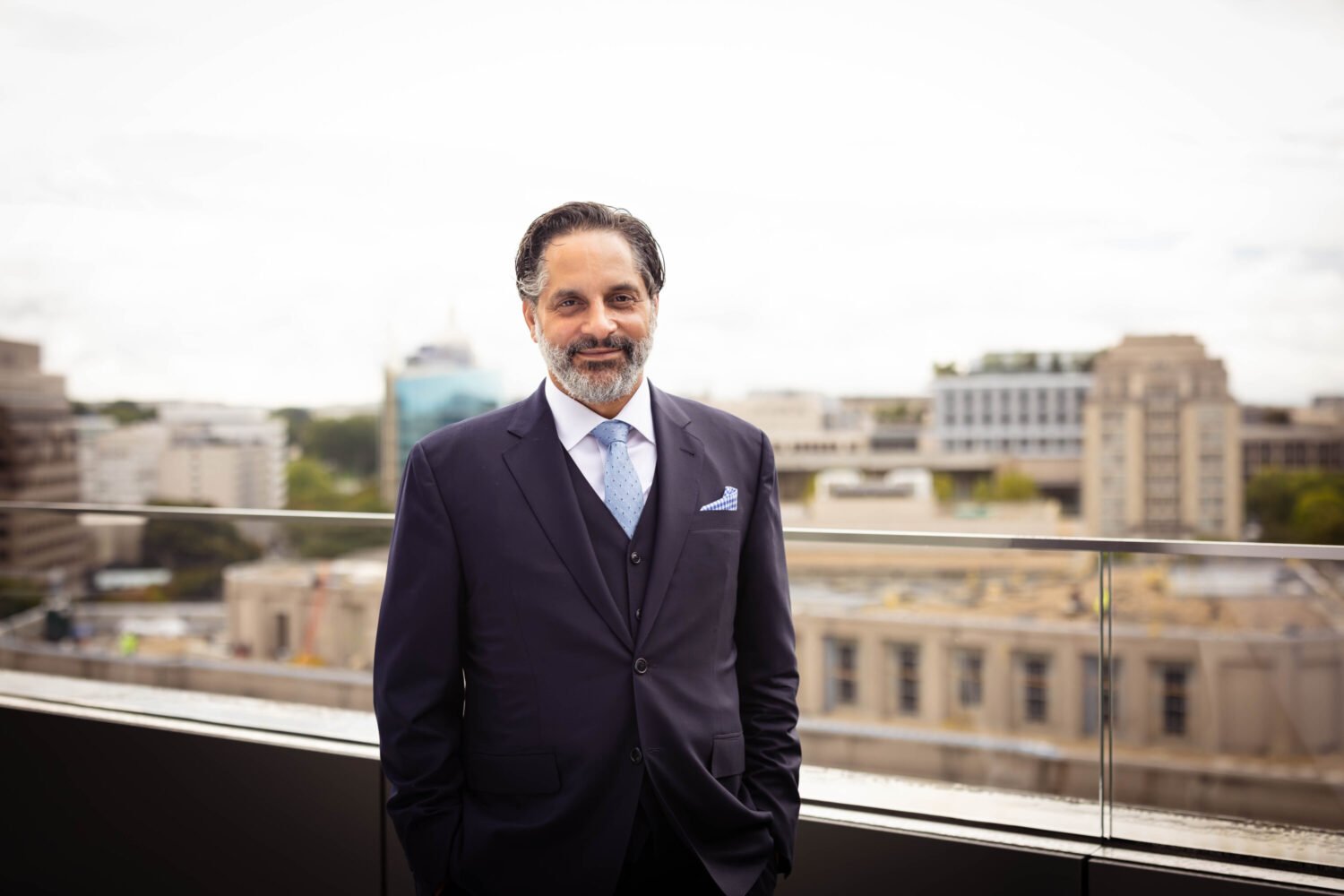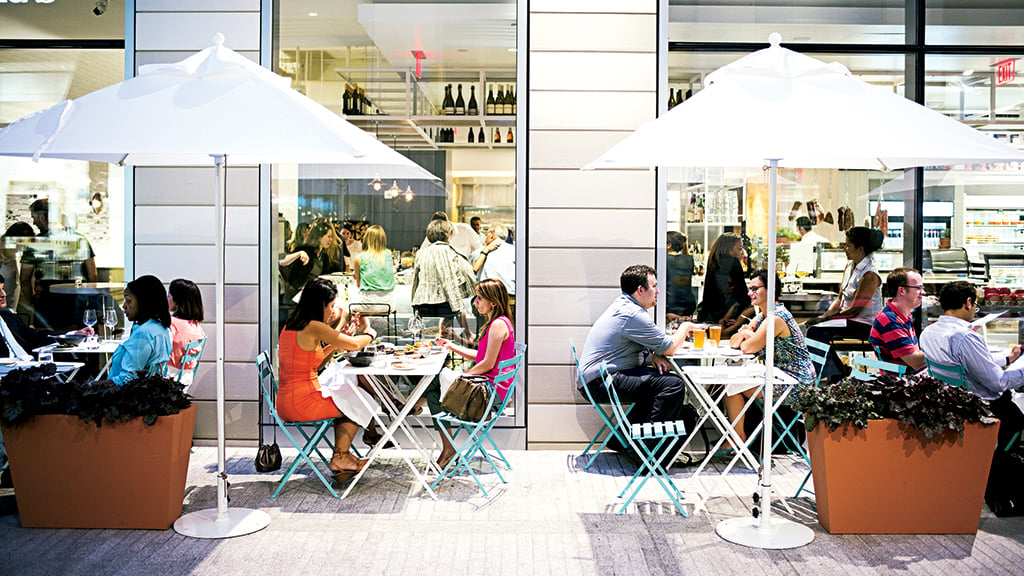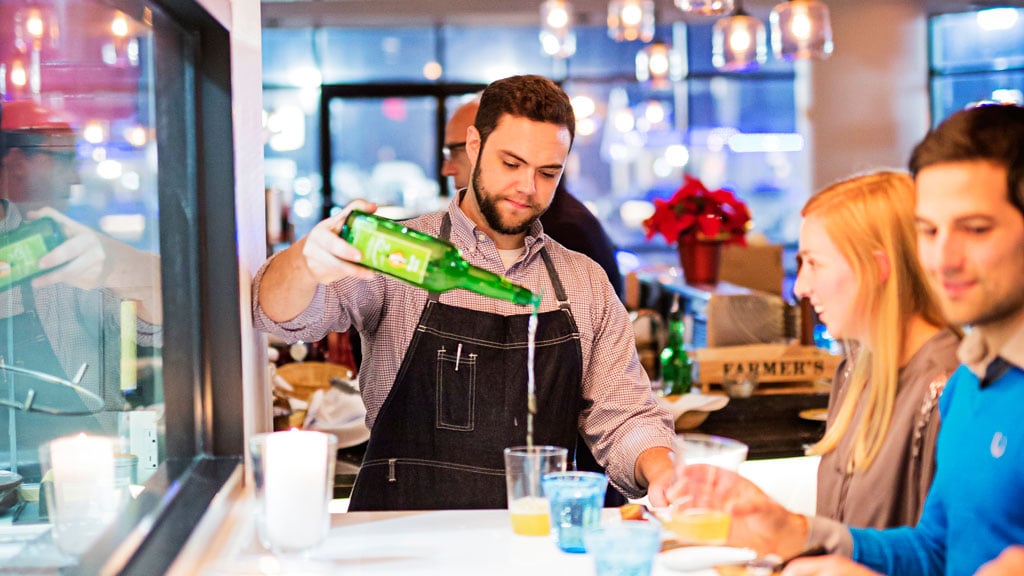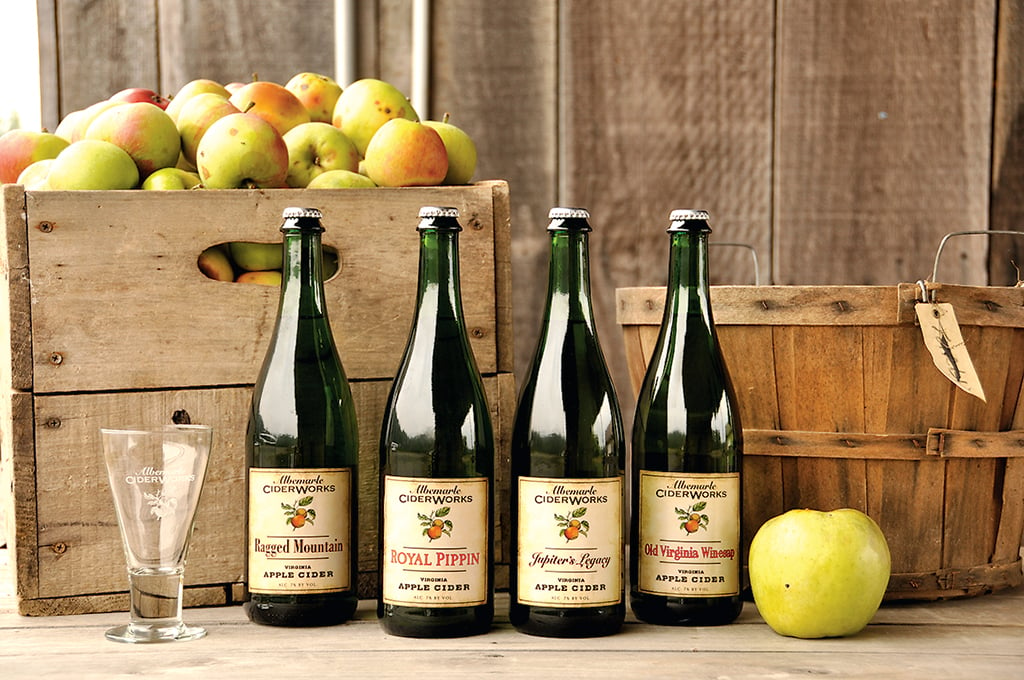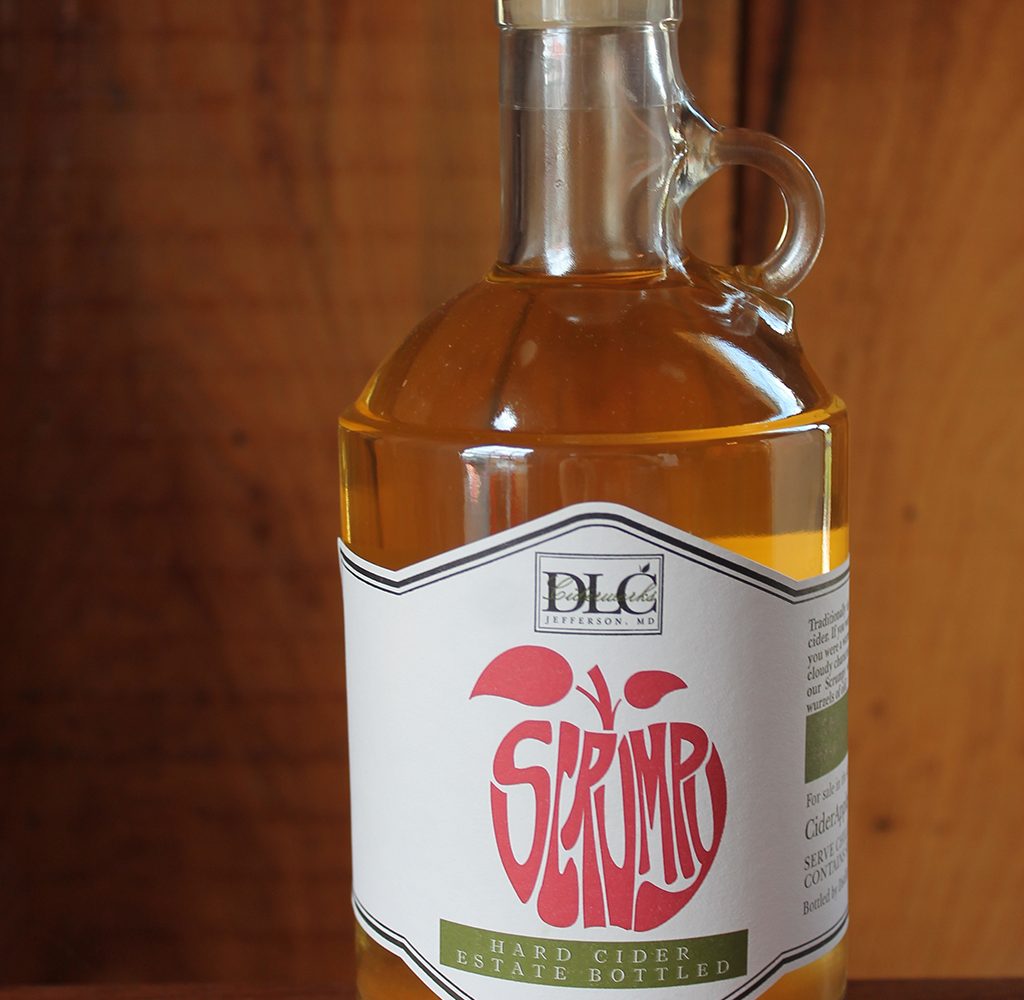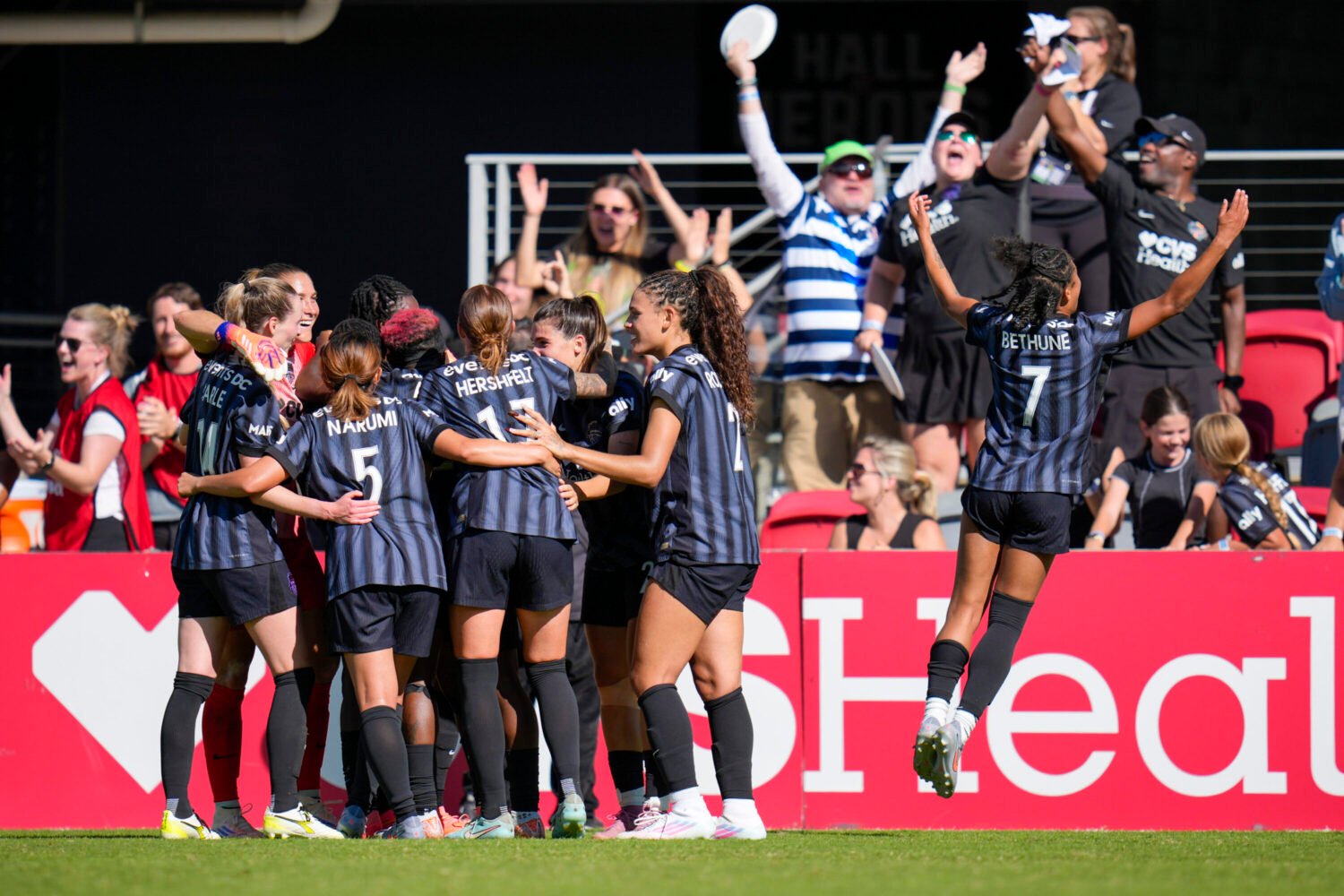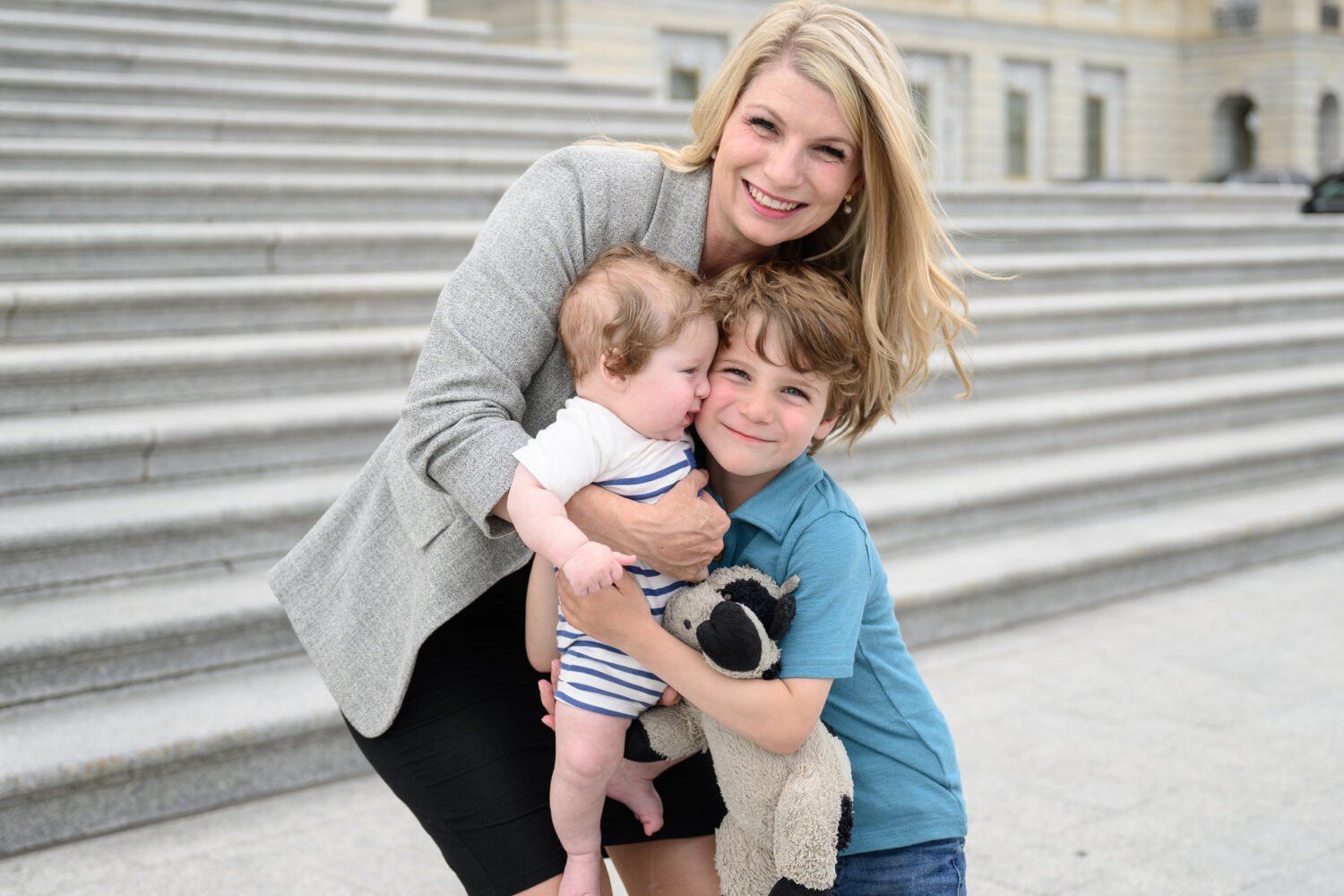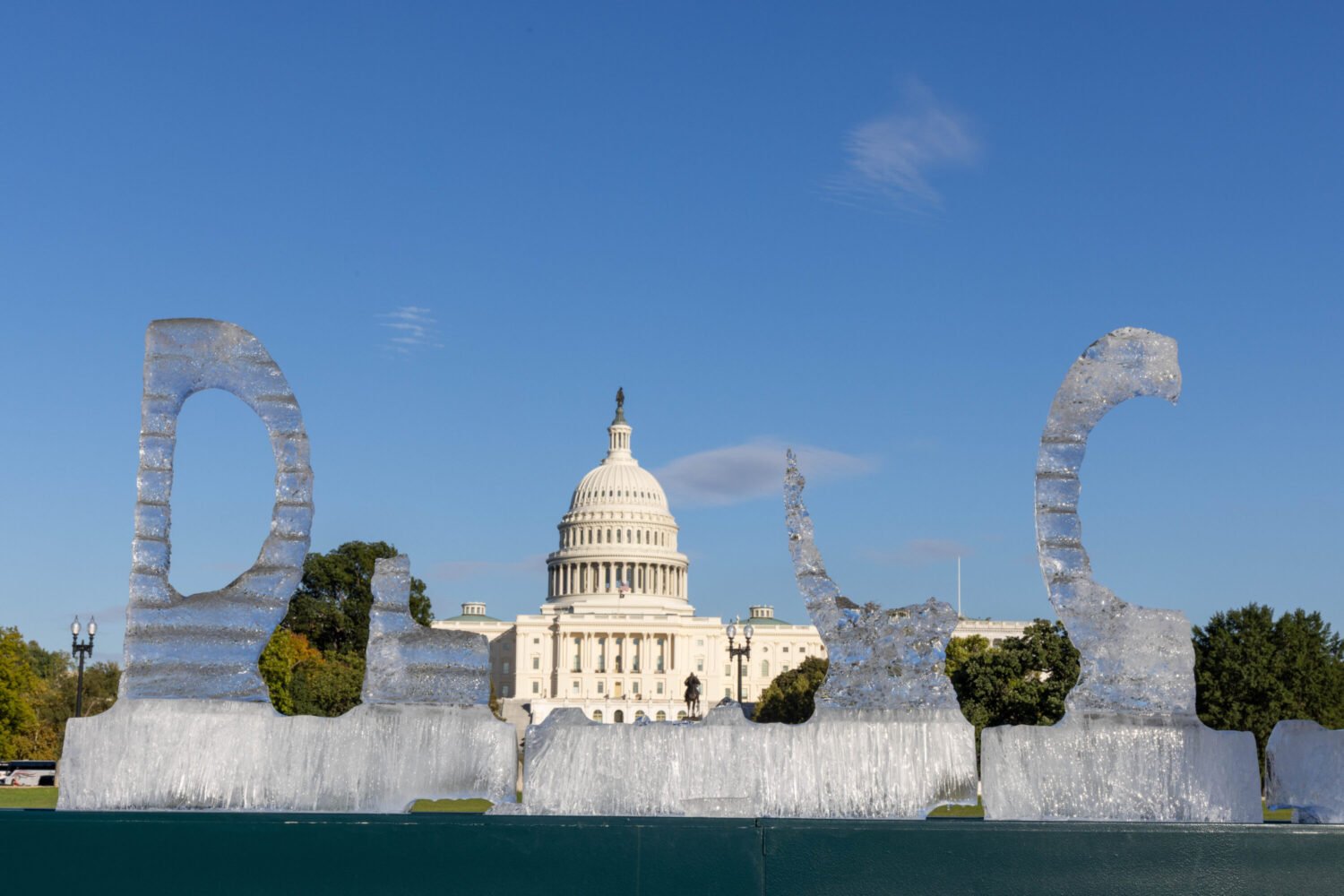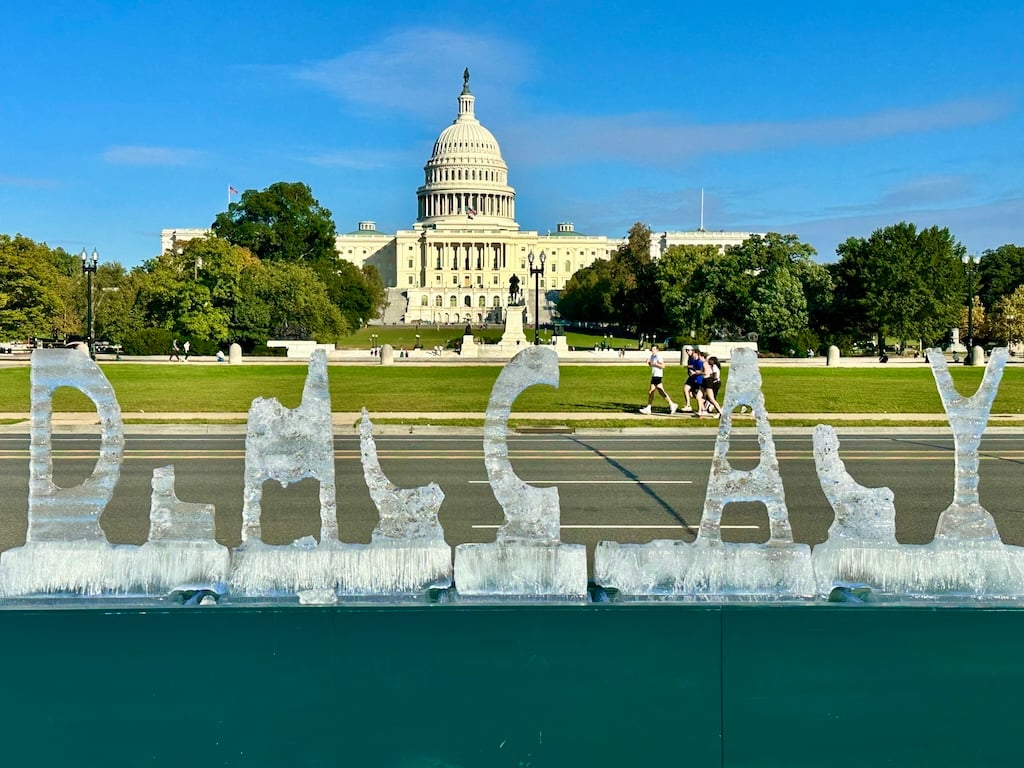Korean food is hot, and we're not just talking pepper. Long overshadowed by its Japanese and Chinese cousins, Korean cuisine is coming into its own, and Washington is one of the first US cities to catch the wave.
Some Americans have enjoyed Korean barbecue. Many know about kimchee–the term refers not simply to pickled cabbage but to many varieties of fermented vegetables, fruits, and seafood. We might have encountered gochu jang–the essential ingredient of Korean red-pepper paste–and so tend to believe that all Korean food is hot and spicy.
But all Korean food does not taste the same, any more than all classical music sounds the same. Though it bears a resemblance to other Asian cooking, Korean food is a distinct cuisine.
Korean food is more vibrant than Japanese and less oily than Chinese food. It owes its characteristic pungency to liberal amounts of garlic, scallions, and red pepper. Passing near a Korean restaurant, taste buds perk up at the smells of grilled beef tenderloin and grilled short ribs in their sweet marinade. Vegetarians can thank Buddhist tradition and the influence of ancient Chinese medicine for Korean cuisine's diverse array of salads, fermented vegetables, and tofu dishes.
Categories of Korean cuisine are gui (broiled and barbecued dishes), chongol (hot pots), chigae (stews), bap (rice), guk (soup), namul (salads), pokkum (stir-fried dishes), and jeon (pan-fried dishes).
Korea's most striking visual contribution to East Asian cuisine is panchan. While Japanese restaurants offer the occasional pickle on the side and Chinese restaurants push deep-fried noodles, Korean restaurants serve little side dishes that almost amount to a meal in themselves–kimchee, dried fish, marinated vegetables, roasted seaweed. These Korean tapas are free and usually unlimited. Their number and variety are dictated by the status of the meal (and sometimes the status of the guests). Even the simplest Korean meal is a constellation of food, small plates of colorful morsels that complement the flavors of the main dish.
It was once hard to enjoy the full range of Korean cuisine in the Washington area. But the region is now home to the nation's third-largest Korean community–more than 100,000 strong. A critical mass of Korean restaurants has produced a Koreatown in Northern Virginia. A large Korean community in Maryland supports a dispersed group of eateries. Although it is more difficult to locate Korean food in the District, you can find it if you look hard enough.
The first rule for people who want to get acquainted with the rich tradition of Korean cooking is to stay away from the buffet. These lunchtime spreads at Korean restaurants tend to feature a sort of pan-Asian cooking, not the genuine article.
The first stop on the local Korean circuit traditionally has been Pentagon City. Woo Lae Oak (1500 S. Joyce St.; 703-521-3706) has served up dishes from its large menu of Korean specialties to Al Gore, the Foo Fighters, every visiting Korean dignitary, and the just plain curious since 1982.
According to manager Chong Son Kang, Woo Lae Oak serves more than 150,000 people a year, most of them non-Koreans. The proprietors are proud of introducing Korean food to a wider audience. To do so, they have adapted their recipes to American tastes. The food at Woo Lae Oak "is milder than the original, more Westernized," explains Kang. "It is less spicy and a little bit sweeter."
On a recent visit some Korean friends and I verified that Woo Lae Oak is justifiably proud of its barbecue–the beef and pork are tender and tangy. Posot juk, a smooth Korean version of mushroom risotto, is perfect for the spice-averse. The soondubu (tofu stew) was tasty but not very spicy. The posot chongol (mushroom stew) was rich and satisfying but sweeter than traditional versions.
In Falls Church, Beewon (6678 Arlington Blvd.; 703-533-1004)–Secret Garden in English–is another pioneer. "When we opened in the early 1980s," manager Hyo Don Lee says, "only 20 Korean churches served this area. Now there are more than 300." Beewon relies on non-Koreans for half its business. Pictures of Korean specialties in the foyer assist newcomers. Beewon doesn't adjust its recipes to American tastes. Witness its current special–raw fish served still wiggling. It's a big hit among Korean patrons but still a bit exotic for most Americans.
Good Choices in Annandale's Koreatown
At the junction of Columbia Pike and Little River Turnpike is a concentration of Korean and Korean-American culture. Paul Im, who has lived in Virginia since 1969 and has run Annandale Hardware for 24 years, remembers when the area was mostly countryside and the Korean population was centered in Arlington. Im and others eventually moved to Annandale. "It's close to the downtown, but it's not a big city," Im says. "The atmosphere is like a small town in Korea."
To see whether Washingtonians are ready for the next big ethnic cuisine, I took two non-Korean friends to Annandale's Todamgol (7331 Little River Tpk.; 703-941-3400) for their first taste of real Korean food. For appetizers, we had mandu (dumplings) that were thin-skinned and flavorful, and a generous portion of green-bean pancakes that were crispy on the outside and full of squid morsels on the inside.
For entrées, my friends tried tolsot bibim bap. Bibim bap means mixed rice, and is destined to challenge fried rice on the list of ubiquitous Asian foods. The tolsot version is served in a sizzling-hot stoneware bowl filled with a colorful array of vegetables, sometimes with ground beef, sometimes with a fried egg. Todamgol also serves a seafood bibim bap filled with squid and shrimp in a not-too-spicy red sauce.
"This is great!" one friend exclaimed. "Real comfort food," the other purred.
I tried the kongpiji, a nutty stew of soybean dregs prepared with kimchee and pork, a dish that used to be hard to find in this area–until Todamgol and a new crop of restaurants expanded the Korean food options for Washingtonians.
In korea, restaurants specialize in particular types of food. There are also regional variations within Korea, but the variation is not as wide as in China. Korean restaurants in America often try to satisfy all customers by offering omnibus menus.
One benefit of Annandale's growth spurt has been the arrival of Korean specialty restaurants. Pokchangdong (7601 Little River Tpk.; 703-658-0508) serves several varieties of soondubu, including the tenjang (fermented bean paste) with beef, zucchini, potato, and creamy soft tofu; a raw egg cracked into the bubbling stew gives the broth extra smoothness. Diners less adventurous can get the vegetable or seafood versions. Pokchang-dong also serves an excellent white kimchee with pine nuts and grated carrot, guaranteed to be a hit with non-Koreans.
The specialty at Anangol (4215 Annan-dale Center Dr.; 703-914-4600) is hot spicy pork ribs that make a meat lover start salivating. Just as good are the stir-fried mussels, large and plump, prepared with zucchini and onions in an oyster-and-garlic sauce. The waitress also supplied cups of nooronji, a real nostalgia drink for Koreans, made by adding water to the rice burned at the bottom of the rice pot.
Some Annandale restaurants spend little effort trying to appeal to non-Koreans. Po Jang Ma Cha (7203 Columbia Pike; 703-941-7020) specializes in the large plates of food shared by Korean drinking parties. Its youngnyam dubu is a generous and attractive plate of firm white tofu slabs alongside an orange mixture of stir-fried kimchee and pork. The agujim–chunks of monkfish in a thicket of bean sprouts–is a two-sauce dish: The fish is coated in a spicy red sauce, then dipped into a second bath of wasabi and soy sauce.
Po Jang Ma Cha–which means "covered wagon" but refers to the outdoor stalls in Korea that serve snacks and drinks–can be a disconcerting place because meals there often are punctuated by the sound of gunfire. It is located atop the Small Arms Range of Annandale. You have to drink a lot of soju (Korean liquor made from sweet potatoes) before you stop noticing the sound of Virginians taking aim at pictures of Osama bin Laden.
J oining BIBIM BAP and SOONDUBU as potential crossover hits is Korean beef soup, or gomtang. I went to Seoul Gomtang in Vienna (8413 Old Courthouse Rd.; 703-821-1110) to try a bowl. Opened 15 years ago, the Japanese-Korean restaurant features sollangtang, a soup made from the entire cow that is traditionally served at a spring ceremony to ensure a good harvest. The soup looks so creamy because the bones are cooked for 24 hours. In the rich broth are slices of beef, translucent noodles, and a sprinkling of spring onions, to all of which one adds some coarse salt. The ggorigomtang, made from oxtail, has fist-size bones with meat that you dip in a mixture of soy sauce and Japanese mirin. Now that Vietnamese pho has prepared Americans for Asian beef soups, the mild, flavorful gomtang should find a receptive audience.
Dessert at Korean restaurants is usually no more than a slice of fruit or an after-dinner drink like shikhye, a sweet rice concoction. For a different confectionary experience, several places in Annandale sell ttok, a pounded-rice sweet not unlike Japanese mochi. Ttok shops are not easy to find if you can't read Korean script. Nak Won Ttokjip (7317 Little River Tpk.; 703-658-4360) advertises itself in English as Nak Won Catering. Inside you can buy any of a number of panchan, or side dishes, including some not commonly served in restaurants. But the real attraction is the ttok, which comes in many varieties, coated in pounded red beans or multicolored powders of sesame and cinnamon.
A trip to Annandale should include a visit to a cafe to try traditional Korean teas. I'm a big fan of yuja cha, a kind of marmalade tea made from the citron fruit, which I had with spicy octopus kimbap (seaweed rolls) at Café Muse (7356-B Little River Tpk.; 703-658-9351). At Reminisce (4231-R Markham St.; 703-642-3848), a sleek new cafe that shows the latest music videos from Seoul, I tried a rather weak version of maeshil cha (plum tea). At Café Noir (7129 Little River Tpk.; 703-941-0056), I had an excellent cup of yoolmu cha, a thick tea with nuts that tastes rather like a grainy British Horlicks.
Several Korean bakeries, including the Koryo Bakery (4217 John Marr Dr.; 703-642-0404), sell patpingpatsu, a concoction of sweet beans, fruit, soft candy, and ice that will transport you back to your Korean childhood, even if you never had one.
Finding Seoul Food in the Maryland Suburbs
Annandale has Korean restaurants, Internet cafes, saunas, karaoke bars, and comic-book lending libraries. Maryland's Korean community is smaller, but it supports its share of authentic Korean restaurants.
In Wheaton, Woo Mi Garden (2423 Hickerson; 301-933-0100) serves the best haemul pajon (seafood and scallion pancake) I've ever eaten–perfectly fried, not greasy. The barbecue at Woo Mi Garden is also very good, the kalbi (short ribs) and the squid both fresh and well marinated. The set meal comes with a dizzying array of side dishes, including some of my favorites–fishcake strips, acorn jelly, seaweed stems, and marinated potatoes. I broke with tradition and ordered a Japanese-style dessert, tempura ice cream–a large scoop of green-tea ice cream with a cool but crispy fried crust. Accompanied by a hot cup of green tea, this soothes the taste buds after a spicy meal.
Maryland also supports several restaurants that specialize in particular foods. Seoul Soondae (12203 Veirs Mill Rd., Wheaton; 301-942-5200) advertises its specialty with a picture of a pig in its window. Soondae is Korean sausage. Don't expect anything like hot Italian sausage. Soondae is very mild, stuffed with ground pork, tofu, vegetables, and potato noodles, and served with a dipping sauce of salty dried shrimp. It can be eaten sautéed or in a soup.
Yett Gol (12337-C Georgia Ave., Wheat-on; 301-949-9060), which specializes in similarly humble fare, is a good place to experience Korean fire and ice. The fire comes in the form of kimchee chigae, a stew full of kimchee, pork, and blocks of tofu. The ice comes in the bowl of mul naengmyen, or cold noodle soup. In a large metal bowl, a mound of buckwheat noodles rises above the clear, cold broth. Atop the noodles are shredded cucumbers, a slice of beef, a slice of Korean pear, and half an egg. At Yett Gol, the soup comes with ice cubes, and the noodles are pleasantly chewy. Add some hot mustard and vinegar, and welcome the waitress when she offers to cut your noodles with a pair of kitchen shears.
There are several varieties of Korean cold noodles, including bibim naengmyen (no soup) and hwae naengmyen (with raw fish). But be careful with the latter: Many restaurants use skate, which is cartilaginous and has an ammoniac flavor that most non-Koreans associate more with bathtub cleansers than with food.
Tracking Down Korean Cooking in DC
Practically every corner in DC's commercial districts has a Korean-owned establishment–grocery store, dry cleaner, liquor store, nail salon. So you'd expect to find lots of Korean restaurants in DC? Wrong. The city's Korean business owners typically work long hours and go home to the suburbs. Only about 1,000 Koreans live in DC, so a Korean restaurant must rely mostly on non-Koreans.
In 1995 Jin-ga opened in DC's West End. It served court-style Korean food of the highest quality to well-heeled patrons. The Jinlo Corporation, flush with profits from its sales of soju, spent a fortune on decor and high-tech grill tables. But the strategy was flawed. "They approached food the Asian way," explains designer and former restaurateur Mihae Kim, who tried to advise Jin-ga. "The lunch was expensive, it took a long time, and there wasn't enough turnover." Although the food received high marks, Jin-ga closed after a couple of years.
Besides the lack of a Korean customer base in DC, rents in the District are high, and parking is a problem, so few in the Korean community are willing to risk opening a restaurant there. But several have slipped Korean food into pan-Asian menus. East Street Café (202-371-6788), on the mezzanine level of Union Station serves a version of bulgogi (beef barbecue) that is tasty but somewhat saltier than the original. Pan Asian Noodles (2020 P St., NW; 202-872-8889) offers japchae–cellophane noodles with strips of meat and vegetables and a pronounced flavor of sesame oil. At Sticks & Bowls (1300 Connecticut Ave., NW; 202-296-4001), you can get a kimchee rice bowl or a kimchee noodle soup among the various pan-Asian offerings. For now, assembling a whole Korean meal in DC requires some hunting and gathering.
One of the many successful Korean businesses in DC is Soho Cafe, a salad bar extraordinaire that has grown to eight locations since it started in 1992. Soho is branching out to the suburbs with dinner buffet restaurants planned for Bethesda and Reston.
The Soho buffet is packed with such dishes as teriyaki salmon and crispy sea bass. There's a salad station, a grill, an ice-cream and coffee bar, and four buffet tables with everything from Italian to soul food. The Connecticut Avenue location also has sushi and Mongolian barbecue. But where's the Korean?
"It's a Korean-owned business, so even the Italian dishes have Korean touches," says owner Des S. So, whose father pioneered the salad-bar concept in New York. "On the other hand, we don't want to make it too Korean." Soho's sole Korean offerings, japchae and kimchee, are almost lost among the bounty.
Down at the Florida Avenue Market, the wholesale food distribution center in Northeast DC, 85 percent of the merchants are Korean and Chinese, says the Reverend Sangjin Choi, a Korean minister who often works in the area and who first took me there for a Korean meal. Several informal places offer a mixture of American breakfasts, Latin-American food from steam trays, and, if you look hard enough, authentic Korean cuisine. The best of the restaurants I tried was Young's Deli (325 Morse St., NE; 202-543-1417). Its jaeyook pokkum, a pork stir-fry with onions in a sweet and spicy sauce, came with three panchan, rice, and a bowl of bean-sprout soup. The Korean choices are listed on the wall in hangul script, but the owner will provide a translated list if you ask.
For now, the lunch joints in Florida Market are the only Korean restaurants in the District. But as more Koreans come to DC, and as Korean food moves into the mainstream, it may be joined by other Korean restaurants–perhaps one that specializes in bibim bap, another in soondubu, a third in naengmyen.
And the Future of AsianCooking Is . . . Fusion?
In Korea, much is made of "pure Korean" cuisine, which is presumably without Japanese, Chinese, or Euro-American influences. All food, however, is fusion cuisine–it's just a question of when the fusion took place. Take kimchee, the most famous of Korean specialties. The red pepper that is so much part of most kimchee varieties wasn't introduced into Korea until the 18th century (from the New World via Portugal and Japan). The Mongols brought dumplings and rice wine to Korea a few centuries earlier. More modern examples of fusion available on the streets of Seoul are kimchee pizza and bulgogi burritos. On this side of the Pacific, kimchee salsa is popular in Los Angeles.
Japan colonized Korea during the first half of the 20th century, and before that China exerted centuries of less-direct control. Aside from some trade disputes–involving the Japanese lock on the kimchee trade, for instance, or the dumping of Chinese garlic in Korea–food has helped to break down barriers in the region.
Chinese restaurants in Korea serve dishes as peculiarly Korean as chow mein is American. The most popular of these dishes is jajangmyen, noodles with black-bean sauce. I tried a bowl at Tae Song Gwan, a restaurant in Wheaton (11215 Veirs Mill Rd.; 301-949-1500) with the heavy furniture and ornate screens of a 1950s Chinese restaurant. The house-made noodles were excellent, and the black-bean sauce was thick and porky. I'm not a fan of the other varieties of Korean-Chinese food (the fried meats, the seafood noodle), but I'd go out of my way for jajangmyen.
Japanese food is also popular in Korea, and it's common to find the cuisines mixed in the Washington area, at buffets or at the many Korean-owned sushi restaurants. One of the great bargain lunches in Annandale combines Korean and Japanese food. Yechon (4121 Hummer Rd.; 703-914-4646), in a low-slung building that looks more like a cowboy-boot outlet than a restaurant, is known for its barbecue, but for sheer aesthetics and variety I recommend the lunchbox. The $7.95 chicken bulgogi was perfect for those who might require a Japanese crutch when approaching Korean cuisine. My box contained a slice of California roll, several Korean and Japanese appetizer morsels, salad with Japanese-style ginger dressing, chicken with string beans Chinese style, and last but not least, the Korean grilled chicken.
At DC's Raku (1900 Q St., NW; 202-265-7258), the fusion goes one step further, and the cuisines are mixed in the same dish. In the tuna kimchee rolls, the mouth sizzle of the kimchee and the nose tingle of the wasabi combine perfectly without overpowering the raw fish. The Korean beef noodle soup, a far cry from gomtang, combines Vietnamese-style charbroiled beef with Chinese-style egg noodles; only the kimchee provides a Korean flavor, but it is a welcome addition.
In Takoma Park, Mark Choe has added a number of Korean dishes to his eclectic menu at Mark's Kitchen (7006 Carroll Ave.; 301-270-1884). Along with milkshakes and veggie burgers are bulgogi, mandu, and japchae. "I chose the most popular ones," he explains. "Everything is my own recipe. I changed things to Takoma Park-style. I figure out what my customers want." He doesn't use sugar, so his Korean food is less sweet. He caters to the vegetable-friendly and health-conscious atmosphere of the neighborhood. Instead of coffee, he has focused on tea and sells Korean ceramic tea sets. Choe plans to open another restaurant, perhaps with more daring alterations to traditional Korean dishes, such as a build-your-own bibim bap where the customer chooses from among two dozen ingredients.
Korean-Chinese and Korean-Japanese are perhaps predictable combinations, but what about Korean-African-American? Des S. So has introduced a cold collard-green salad with Korean flavors at his Soho Cafe. And he dreams of opening a restaurant featuring shabu shabu, the Japanese version of hot pot, but with a Korean touch. As with beef noodle hot pot–a delicious version of which I ate at Beewon–the waitress will add a plate of fresh noodles to absorb the remaining broth.
Korean restaurants as diverse as Woo Lae Oak and Mark's Kitchen have reached a new audience in part by adapting traditional Korean recipes to American palates. But fusion and adaptation are risky enterprises. "Koreans are very proud of their culture, and they want to preserve identity," says Gregory Shook of the Korean Cultural Service. "And food is one of the things that make Korean identity unique. Once you start deviating from the traditional recipes, it might be a slight that Koreans might not like."
Or maybe we can have it both ways–authentic Korean and multicultural blends with broader appeal. In any case, it's a good bet that someday bibim bap, soondubu, and naengmyen will be as familiar to Washingtonians as lo mein and teriyaki. Korean food is coming to a restaurant near you. Get ready for a brand new taste.
Learning to Cook Korean–and Finding the Ingredients
There are many Korean-owned restaurants in the District, but they either are salad bars or serve Japanese food. "We are still far behind the Japanese," says Korean author Hi Soo Shin Hepinstall, who is working to make Korean food popular here.
A novelist in Korea, Hepinstall decided in the 1980s to study Korean cuisine. "I needed to learn it systematically," she says, "like an engineer coming to study the subject in the United States." To begin, she took a summer course at the Cordon Bleu cooking school in Paris. On the first day of class, when students explained their reasons for attending, several confessed their hopes of one day opening a French restaurant. Hepinstall announced that she was there to write a Korean cookbook. No one blinked an eye, she says.
Her cookbook, Growing Up in a Korean Kitchen (Ten Speed Press; $29.95) came out in 2001. It is a beautiful book–with photographs by Hepinstall–that unlocks the mysteries of Korean cuisine.
The Korean Cultural Service (2370 Massachusetts Ave., NW; 202-797-6343), which is connected to the Korean Embassy, distributes a booklet entitled "The Wonderful World of Korean Food" that identifies Korean dishes, explains food etiquette, and provides a few recipes.
A recipe is only as good as its ingredients, and the Silver Spring-based Hepinstall praises the Korean-owned supermarkets in the Washington area."They really saved me when I was writing this book," she says.
Two major supermarkets cater to the ethnic food market: Lotte (13625-A Georgia Ave., Silver Spring, 301-962-3355; 3250 Old Lee Hwy., Fairfax, 703-352-8989) and Han Ah Reum (12015 Georgia Ave., Silver Spring, 301-942-5071; 8103 Lee Hwy., Falls Church, 703-573-6300). When my partner and I returned to the United States after three years in Asia, we despaired of being able to get the foods we'd grown to love.
At both supermarkets we can get everything we bought in Seoul–from kim (seasoned seaweed) and boricha (barley tea) to hard-to-find vegetables and prepared foods –and usually the products are cheaper. The Lotte stores also have food courts with a good selection of cheap eats.
SOUL FOOD, TOO
Because many Korean immigrants here started businesses in poor, largely African-American neighborhoods, relations between the two communities sometimes have been tense. The Reverend Sangjin Choi works in a neighborhood near Howard University. His organization, Action for Peace through Prayer and Aid (APPA), tries to resolve conflicts between Korean merchants and African-Americans.
To demonstrate that Koreans are contributing to areas where they set up business rather than simply taking money out, Choi uses money contributed by Korean businesses and churches to help the homeless. When they hold events, APPA serves Korean food like bulgogi and kimchee.
Kimchee for the homeless? Explains Choi, "When I served kimchee for the first time to our African-American participants, they said, 'It's too hot.' Now they say 'I love kimchee,' which also means 'I love Koreans.' So kimchee is a real tool for reconciliation." –JF
A Kimchee Museum in College Park
Maryland has a smaller Korean community than Northern Virginia, but it soon will have the area's first Korean tourist attraction. In 2004, the world's second kimchee museum will open in College Park.
Maryland's Kimchi Museum is the brainchild of Helen Kim, who ran a buffet restaurant in Rockville. In 1998 she visited the kimchee museum in Seoul and left disappointed. Although it does an adequate job of explaining the history and preparation of kimchee, its tasting room offers less of a selection than you'd find at an average Korean restaurant.
The College Park museum not only will tell the story of kimchee, it also will provide a full experience of this most essential of Korean foods, complete with restaurant and gift shop.
There will be a garden for growing kimchee ingredients, a factory to produce kimchee, and even a facility affiliated with the Pusan National University, where researchers will study the dish's health benefits. According to Kim, the Korean Tourism Bureau already has put the museum on its itineraries for future busloads of Korean tourists visiting America. –JF





